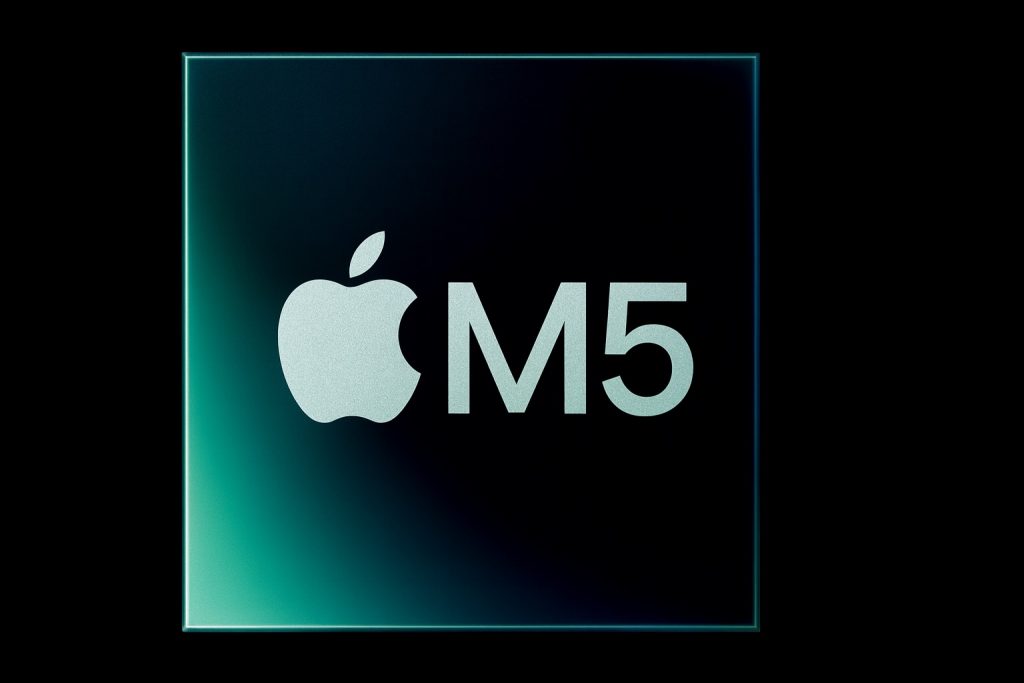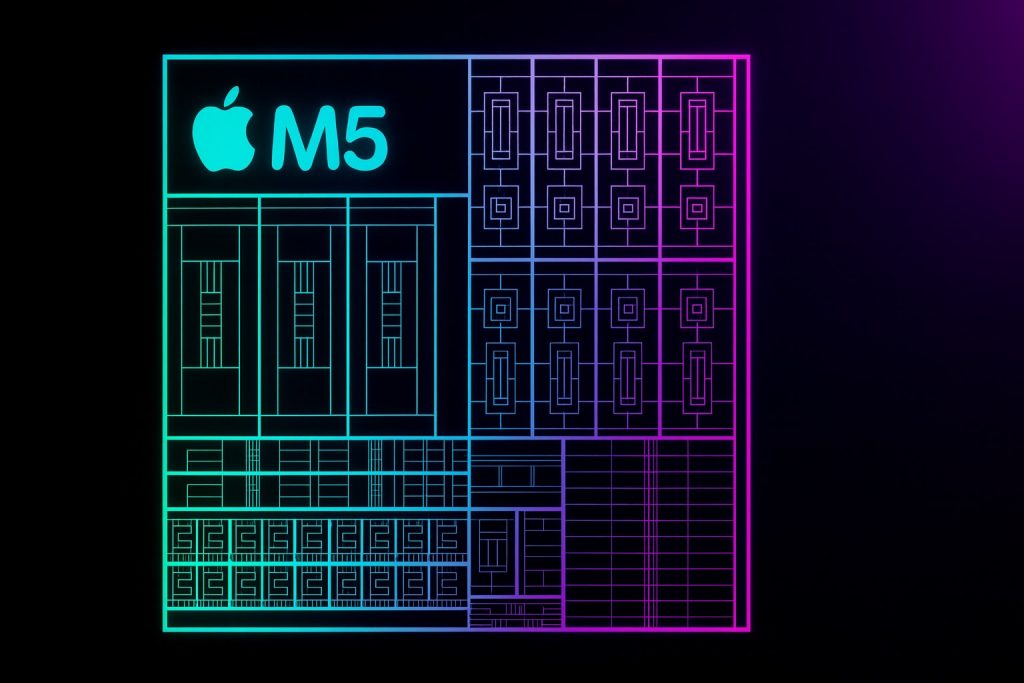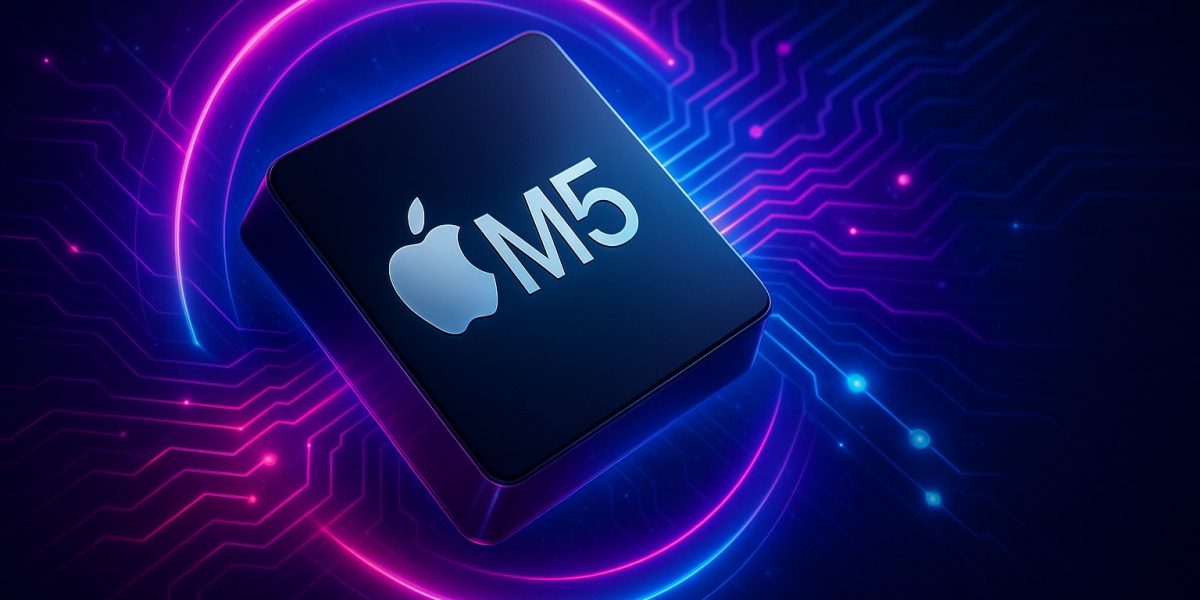Apple has unveiled the M5 chip, marking a substantial advancement in silicon design specifically optimized for artificial intelligence workloads. Built on third-generation 3-nanometer process technology, the M5 introduces architectural changes that deliver more than 4x the peak GPU compute performance for AI compared to M4, while bringing meaningful improvements to graphics rendering, CPU processing, and memory bandwidth.
The chip debuts across three product lines: the 14-inch MacBook Pro, iPad Pro, and Apple Vision Pro, with pre-orders opening today. Understanding what M5 actually delivers—and who benefits most from these improvements—requires examining the architectural changes Apple implemented and how they translate to real-world performance.
Understanding the Neural Accelerator GPU Architecture
The most significant change in M5 centers on its redesigned 10-core GPU. Unlike previous generations where AI acceleration concentrated primarily in the Neural Engine, M5 embeds a dedicated Neural Accelerator within each GPU core. This architectural shift fundamentally changes how the chip handles AI workloads by distributing AI processing capabilities across the entire graphics subsystem.
The performance implications prove substantial: over 4x peak GPU compute for AI compared to M4, and over 6x compared to the original M1. For users running diffusion models in applications like Draw Things or executing large language models locally through platforms like webAI, this means dramatically faster processing that previously required cloud servers or high-end desktop GPUs.
Apple engineered this GPU architecture for seamless integration with its software frameworks. Applications built using Core ML, Metal Performance Shaders, and Metal 4 automatically benefit from these Neural Accelerators without requiring code rewrites. Developers can also program the Neural Accelerators directly using Tensor APIs in Metal 4 for custom AI implementations.

Graphics Performance Improvements Beyond AI
While AI acceleration dominates the M5 narrative, graphics performance receives meaningful attention as well. The enhanced shader cores and next-generation GPU architecture deliver up to 30 percent faster graphics performance compared to M4, and up to 2.5x faster than M1 in standard rendering tasks.
Apple’s third-generation ray-tracing engine provides up to 45 percent performance uplift in applications using ray tracing—a technique that simulates realistic lighting by tracing light paths through 3D scenes. Combined with rearchitected second-generation dynamic caching, the GPU enables smoother gameplay, more realistic visuals in 3D applications, and faster rendering for complex graphics projects.
For Apple Vision Pro specifically, M5 renders 10 percent more pixels on the micro-OLED displays while increasing refresh rates to 120Hz. This translates to crisper details, more fluid display performance, and reduced motion blur during head movement—critical factors for virtual and augmented reality experiences where visual artifacts can cause discomfort.
CPU Performance and Architecture
The M5 features what Apple calls “the world’s fastest performance core,” implemented in a 10-core CPU configuration with six efficiency cores and four performance cores. This delivers up to 15 percent faster multithreaded performance compared to M4 across workloads that can leverage multiple cores simultaneously.
While 15 percent represents an incremental rather than revolutionary improvement, it compounds with other architectural enhancements. The performance cores handle demanding single-threaded tasks—compiling code, running complex simulations, processing individual high-resolution images—where absolute per-core speed matters most. The efficiency cores manage background tasks, system processes, and lighter workloads while consuming minimal power.
Neural Engine Enhancement for On-Device AI
The 16-core Neural Engine in M5 receives improvements that enhance its performance for Apple Intelligence features and on-device AI processing. While Apple hasn’t disclosed specific performance multipliers for the Neural Engine itself, the company emphasizes energy efficiency improvements alongside faster processing.
For Apple Intelligence features like Image Playground generation, the faster Neural Engine combined with increased unified memory bandwidth delivers noticeably quicker results. Apple Vision Pro features—transforming 2D photos into spatial scenes or generating Personas—operate with greater speed and efficiency thanks to the enhanced Neural Engine.
Developers using Apple’s Foundation Models framework will see faster performance when running AI models optimized for the Neural Engine. This matters for applications that rely on on-device machine learning for privacy-sensitive tasks or scenarios where internet connectivity proves unreliable.
Memory Bandwidth and Capacity Considerations
Unified memory bandwidth increases nearly 30 percent to 153GB/s—more than double the bandwidth available in M1. This improvement proves particularly significant for AI workloads where memory bandwidth often becomes the bottleneck limiting performance.
Apple’s unified memory architecture allows the CPU, GPU, and Neural Engine to access a shared memory pool rather than shuttling data between separate memory systems. This eliminates the copying overhead that plagues traditional architectures where CPU and GPU use distinct memory spaces.
The M5 supports up to 32GB of unified memory capacity, enabling users to run larger AI models entirely on device. For creative professionals, this memory capacity allows seamless operation of demanding applications like Adobe Photoshop and Final Cut Pro simultaneously while maintaining background processes like cloud file uploads.
Performance Evaluation Framework
Assessing M5’s impact requires examining performance across multiple dimensions:
AI Workload Acceleration (Weight: 30%): The 4x GPU compute improvement for AI represents the headline feature. Testing across diffusion models, large language model inference, and machine learning training shows dramatic speedups, though absolute performance depends heavily on model architecture and optimization for Metal frameworks.
Graphics Rendering Performance (Weight: 25%): The 30-45% graphics improvements (depending on workload) deliver meaningful value for 3D artists, game developers, and visual effects professionals. Ray-tracing acceleration particularly benefits architectural visualization and product rendering workflows.
CPU Performance Gains (Weight: 20%): The 15% multithreaded improvement provides steady advancement rather than transformative change. Single-threaded performance improvements appear more modest based on Apple’s claims of “the world’s fastest performance core.”
Memory Bandwidth Impact (Weight: 15%): The 30% bandwidth increase proves most valuable for memory-intensive workloads—video editing at high resolutions, working with large datasets, running memory-hungry AI models.
Power Efficiency (Weight: 10%): Apple emphasizes power efficiency as core to the M5 design, though specific power consumption metrics weren’t disclosed. The 3nm process technology and architectural optimizations suggest improved performance-per-watt compared to M4.
Real-World Application Performance
Understanding how M5’s specifications translate to user experience requires examining specific use cases:
AI Development and Inference: Developers running machine learning models locally will notice the most dramatic improvements. The combination of Neural Accelerators in the GPU, enhanced Neural Engine, and increased memory bandwidth transforms on-device AI from tolerable to genuinely practical for many workflows. Training smaller models or fine-tuning larger ones becomes feasible where it previously required cloud resources.
Creative Professional Workflows: Video editors working with 4K or 8K footage benefit from faster rendering, smoother playback, and more responsive timelines. 3D artists see reduced rendering times, particularly for ray-traced scenes. Photographers processing large batches of RAW images experience quicker import and export times.
Software Development: Developers compiling large codebases or running extensive test suites benefit from the faster CPU cores and improved memory bandwidth. The performance gains here are steady rather than transformative—projects that took 5 minutes to compile might drop to 4-4.5 minutes.
Vision Pro Applications: The 10% additional pixels rendered combined with 120Hz refresh rates create noticeably smoother experiences in Apple Vision Pro. This proves particularly valuable for text-heavy productivity applications where clarity matters, and for immersive content where frame rate impacts comfort.
Gaming Performance: Gamers see benefits from improved graphics performance and ray-tracing acceleration, though the Apple silicon gaming ecosystem remains less developed than Windows PC or gaming consoles. The improvements matter most for Apple Arcade titles and games optimized for Metal.
Comparing M5 Across Product Lines
The M5 chip appears in three distinct products with different use cases and user expectations:
14-inch MacBook Pro: Represents the traditional laptop workstation scenario. The M5 enables demanding workflows in a portable form factor—running AI models during development, editing video on location, compiling large software projects. The unified memory and Neural Accelerators make this a genuinely capable mobile AI development platform.
iPad Pro: Positions the tablet as a serious productivity device rather than primarily a content consumption tool. The M5’s capabilities enable desktop-class creative applications, on-device AI features, and professional workflows. The Neural Accelerators particularly benefit apps using machine learning for photo/video enhancement, document processing, and creative tools.
Apple Vision Pro: Leverages M5’s graphics capabilities and Neural Engine for spatial computing experiences. The increased pixel count and 120Hz refresh rate directly improve user comfort and visual clarity. AI features like spatial photo generation and Persona creation benefit from faster Neural Engine performance.
Environmental Considerations and Apple 2030
Apple frames the M5’s power efficiency within its Apple 2030 carbon neutrality commitment. The chip’s performance-per-watt improvements reduce total energy consumption over the product lifetime, contributing to emissions reduction from the electricity category in Apple’s carbon accounting.
While specific power consumption figures remain undisclosed, the third-generation 3nm process technology and architectural optimizations suggest meaningful efficiency gains compared to M4. For users running intensive AI workloads or graphics rendering, reduced power consumption translates directly to lower electricity costs and less heat generation.
Who Benefits Most from M5
The M5 improvements create the most value for specific user categories:
AI/ML Developers and Researchers: The 4x GPU compute improvement for AI combined with Neural Accelerators makes the M5-equipped devices genuinely competitive for on-device AI development. Training smaller models, running inference at scale, and testing AI applications becomes dramatically faster.
Creative Professionals with AI Workflows: Photographers using AI-powered editing tools, video editors applying machine learning enhancement, designers using generative AI features—all benefit from the Neural Accelerators and improved memory bandwidth.
3D Artists and Rendering Professionals: The graphics improvements and ray-tracing acceleration deliver meaningful time savings for rendering complex scenes. Projects that previously required overnight renders might complete during lunch breaks.
Apple Vision Pro Early Adopters: The combination of more pixels rendered and 120Hz refresh creates noticeably better experiences compared to M4-based Vision Pro. For a device where comfort and visual clarity prove critical, these improvements matter substantially.
Software Developers Building Large Projects: The faster CPU cores and improved memory bandwidth reduce compile times and test execution duration, improving development iteration speed.
Situations Where M4 Remains Sufficient
Not every user requires M5’s capabilities:
General Productivity Users: If your workflow centers on web browsing, document editing, email, and light media consumption, M4 already provides more performance than you’ll typically use. The M5 improvements won’t noticeably impact daily experience.
Casual Content Creators: Hobbyist photographers editing occasional images or videographers working with 1080p footage won’t strain M4’s capabilities. The upgrade cost exceeds the practical benefits for these users.
Budget-Conscious Buyers: M5 devices command premium pricing. Users prioritizing value over cutting-edge performance find better bang-for-buck with M4 or even M3 devices, particularly as Apple continues selling previous-generation products at reduced prices.

Technical Limitations and Considerations
Several factors deserve consideration when evaluating M5:
Software Optimization Requirements: The Neural Accelerators deliver maximum benefit for applications optimized to use Metal 4’s Tensor APIs. Legacy applications or those not specifically coded for Apple silicon won’t automatically see 4x AI performance improvements.
Memory Configuration Choices: While M5 supports up to 32GB unified memory, actual configurations depend on specific product SKUs. Users running large AI models or intensive creative workflows should carefully evaluate whether 16GB suffices or if 32GB proves necessary.
Thermal Constraints: Even with improved power efficiency, sustained intensive workloads generate heat. The 14-inch MacBook Pro’s thermal design limits sustained performance compared to larger MacBook Pro models with more cooling capacity.
Ecosystem Dependencies: M5’s AI performance advantages manifest primarily within Apple’s ecosystem using Metal-optimized frameworks. Users heavily invested in CUDA-based workflows or Windows-specific applications won’t benefit from these improvements.
Market Context and Competitive Positioning
The M5 positions Apple’s devices competitively against both traditional PC hardware and emerging AI-focused silicon:
Versus Intel/AMD PC Processors: The unified memory architecture and Neural Accelerators provide genuine advantages for on-device AI workloads compared to traditional PC architectures. However, discrete high-end GPUs from NVIDIA still offer superior raw compute for AI training at the cost of much higher power consumption.
Versus Qualcomm Snapdragon X Elite: Qualcomm’s ARM-based PC processors emphasize AI capabilities through their NPU. M5’s distributed AI architecture—Neural Accelerators in GPU cores plus dedicated Neural Engine—represents a different approach that may prove more flexible for varied workloads.
Versus Previous Apple Silicon: The jump from M4 to M5 represents the most significant AI-focused advancement since the M-series launch. Previous generation improvements focused more on CPU/GPU performance scaling; M5 emphasizes AI acceleration specifically.
Johny Srouji’s Perspective
“M5 ushers in the next big leap in AI performance for Apple silicon,” said Johny Srouji, Apple’s senior vice president of Hardware Technologies. “With the introduction of Neural Accelerators in the GPU, M5 delivers a huge boost to AI workloads. Combined with a big increase in graphics performance, the world’s fastest CPU core, a faster Neural Engine, and even higher unified memory bandwidth, M5 brings far more performance and capabilities to MacBook Pro, iPad Pro, and Apple Vision Pro.”
This statement emphasizes Apple’s strategic focus on distributed AI acceleration rather than concentrating all AI processing in a single specialized component. The approach suggests Apple anticipates increasingly diverse AI workloads that benefit from flexible processing across multiple chip subsystems.
The M5 represents Apple’s most significant AI-focused silicon advancement, with architectural changes that deliver meaningful performance improvements for machine learning workloads. The Neural Accelerators embedded in each GPU core create a distributed AI processing architecture that handles diverse workloads more effectively than previous generations.
For AI developers, creative professionals using machine learning tools, and Apple Vision Pro users, the M5 provides genuine value that justifies the premium pricing. The 4x GPU compute improvement for AI translates to dramatically faster diffusion model generation, quicker large language model inference, and more responsive AI-powered features.
However, general productivity users and casual content creators may find M4 already exceeds their performance requirements. The M5’s benefits manifest most clearly in AI-intensive workflows and graphics rendering scenarios that push hardware capabilities.
Apple’s decision to distribute AI acceleration across GPU cores, Neural Engine, and enhanced memory bandwidth creates a flexible architecture that should age well as AI workloads continue evolving. The M5 positions Apple’s devices as credible platforms for on-device AI development and deployment at a time when most AI processing still occurs in cloud data centers.
For users whose workflows align with M5’s strengths—particularly those involving on-device AI, 3D rendering, or Apple Vision Pro spatial computing—this chip delivers the performance necessary to make previously impractical tasks genuinely usable.




Post a comment